The core objective of xeriscaping is water conservation through the creation of water-efficient landscapes. A properly designed outdoor xeriscape not only reduces water usage by 20 to 50 per cent, but can also reduce chemical usage, requires little maintenance, and can be uniquely aesthetic (AWWA 2010, Green Venture 2011). Xeriscaping also allows for a wide range of trees, shrubs and flowering perennials to create an attractive and sensible yard.
Before planting a xeriscape garden, it is important to plan its overall organization. This involves negotiating the balance between the amount of land dedicated to turf versus xeriscaping and creating water-use zones for plants that correspond to sun exposure and take advantage of the natural flow of water. The overall goal is to reduce much of land allocated to turf, while in turn increasing the efficiency of watering. A well-designed xeriscape should be self-sufficient after its first year of growth, which will result in greatly reduced maintenance requirements in the long term (Sliva 2011, Green Venture 2011).

Figure 20.1: A site plan showing water-use zones.
Once the organizational aspects are worked out, it is important to properly prepare the soil so that it can retain as much water as possible. This involves amending the soil with organic and inorganic materials, such as wood products and peat to increase both its water and nutrient holding capacity. Once the vegetation is planted, the soil will still need some attention, including the addition of mulch and proper annual aeration, to keep growing conditions suitable for the xeriscape vegetation (Bhatt 2005, Davis and Wilson 2005).
The selection of plant material is highly important in xeriscaping. Overall, it is necessary to select species that require little irrigation and maintenance. This means focusing on planting chiefly native species that have deeper roots and can survive primarily on rainwater. These species should then be located in the watering zones that were defined early on. Furthermore, when choosing turf for the non-xeriscaped portions of the garden, it is also possible to choose low-maintenance species that require little water.
Even though a mature xeriscape should function with little to no additional water, it is still necessary to plan out efficient systems for those plants that require more water, and for portions of the garden that are covered with turf. Efficient processes can see water delivered directly to the roots to avoid evaporation, and grey water and rainfall can be used to irrigate plants rather potable mains water (Green Venture 2011).
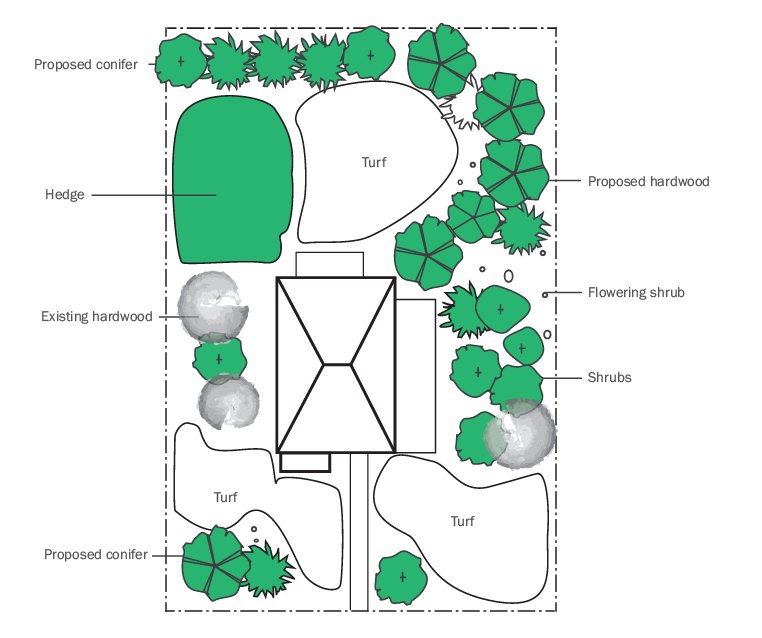
Figure 20.2:Suggested landscaping for water conservation
An initial decision that must be made in the design of a xeriscape is: what should the ratio of turf to xeriscaped land be? Ideally, one should try to reduce the amount of turf in the yard as much as possible due to the fact that conventional lawns can require up to 79 ltr per 0.09 m2 (17 gal per sq ft) per year while xeriscapes require only 13 ltr per 0.09 m2 (2.9 gal per sq ft) per year (Klimchuk 2008). Despite its higher water requirements, however, turf does offer a functional activity space, which xeriscapes do not; therefore it is important to retain some land for turf if needed (AWWA 2010). This means that land that is reserved for turf should only be that which is frequently used, leaving infrequently used patches, as well as areas that are difficult to water, for xeriscaping. This can include areas such as those along fences, the corners of lawns, narrow strips between the house and a sidewalk or driveway, steep slopes where run-off occurs and irregular lawns that do not fit the pattern of most sprinklers (Green Venture 2011).
The organization of a xeriscape should also take into consideration the creation of water-use zones, or hydrozoning, to add efficiency to watering and reduce waste (Kahn 2008). Plants should be clustered together into zones that require frequent watering, occasional watering or no watering at all to avoid over or under watering certain species (AWWA 2010). These zones should then be correlated with the sun path. Zones that require lots of watering should be kept out of very sunny areas to reduce the amount of evaporation from the soil and, similarly, plants with low water requirements should be placed in areas with more sunlight (Green Venture 2011, AWWA 2010). High water-use zones should be limited in size and, if possible, be placed in highly visible areas such as entranceways due to the fact that these plants tend to be more aesthetic and lush (Green Venture 2011).
The last concept involved in the organization of a xeriscaped garden is the topography and subsequent drainage patterns. Slopes which cause excessive run-off should be terraced to allow rainfall to seep into the ground for plant use (Green Venture 2011), while low spots that drain poorly should either be avoided, or amended to aid in their drainage. It is also possible to plant high water-use plants in low spots, provided it is not too wet for the vegetation (Green Venture 2011). By examining the water drainage patterns within the yard, it is possible to customize the area with backfill and redirect the water to locations where it is most needed.
Soil preparation is another important aspect of successful xeriscape design. Initially, it is important to assess the grade of soil currently in place by performing a drainage test. This involves digging a test planting hole and filling it with water. If it drains quickly, it needs to be filled up again. If this water remains in the hole for more than six hours, then the soil grade is low and should be improved for a xeriscape to function successfully (Sliva 2011). Soil grade can be improved first by amending it with organic and inorganic matter such as compost, peat and sand to achieve a soil that has high water retention, but which still drains excess water. Both compost and peat are used due to their high mineral content and high water holding capacity, while sand is needed to improve drainage and increase the oxygen levels within the soil (Green Venture 2011). It is best to mix these three compounds in relatively equal amounts and add them to the earth to encourage deep root growth (Flanigan 2011).
Once the soil bed is appropriately amended, it is beneficial to place a layer of mulch on top. Mulches are cost-effective ways to cool the soil, reduce weed growth, minimize water evaporation and capture rainwater to prevent run-off (Green Venture 2011). It is possible to use both organic and inorganic mulches such as straw, wood chips, pea gravel, marble chips and bark nuggets. Organic mulches are preferable because they decompose over the course of the year to provide fertile soil for the plants. The layer of mulch should never exceed depths of 2.5 to 5 cm (1 to 2 in) for perennials and 5 to 7.6 cm (2 to 3 in) for trees and shrubs due to decreased aeration with excessively deep layers (Green Venture 2011).
Once the vegetation is planted, it is important to maintain the soil richness by aerating. Aeration increases water retention by reducing run-off, increases the oxygen levels within the soil for better growth and also promotes deeper root growth for plants (Green Venture 2011, AWWA 2010). For thicker, clay-like soils as well as turf lawns, it is important to aerate twice a year in the spring and the fall, while xeriscape portions of the lawn only require aeration once a year due to their naturally higher water retention capacity (AWWA 2010, Green Venture 2011).
In addition to organization and soil preparation, because the overall goal is to reduce water consumption within the garden, the selection of vegetation is central to xeriscaping. It is crucial to use species with deep root systems, which in turn will depend less on homeowner watering. For the xeriscaped portions of the yard, selecting native shrubs and trees is best since they are already well adapted to the local rainfall levels, are pestresistant and are able to support themselves in drought through more complex root systems (Green Venture 2011, Sliva 2011). Because climate conditions vary, it is important to contact local growing agencies to find out which perennials and plants will be best for xeriscaping.
Where turf is required, it is important to avoid using conventional bluegrasses, which require a lot of water, instead, choose other, hardier and more water-efficient species such as rye and fescue. Many of these species are almost identical to bluegrass with the exception that they tend to be softer underfoot and require little to no mowing or chemicals (Green Venture 2011). Certain species of fescue, for instance, tend to have deeper roots than bluegrass and therefore retain their colour even during droughts. They are frequently used on golf courses, sports fields and parks due to their deep green colour and natural weed resistance (Khan 2010).
•Shortage of water in many regions
•Need for water conservation/imposed water restrictions
•Environmental awareness
•Interest in organic food
INNOVATIONS
•Advanced domestic irrigation techniques
•Creative use of water zones
Finally, it is important to install effective irrigation in xeriscapes to facilitate maintenance as well as maximize water-usage efficiency. The best way to reduce the usage of hose water in irrigation is to obtain water through natural sources, such as rainwater run-off and grey water. Harvesting run-off water from guttering, outbuildings and paved surfaces and then channelling it into a retention pond or rain barrels can add up to 100,000 ltr (26,000 gal) of saved water each year in temperate climate zones (Green Venture 2011, Sliva 2011). This water should then be dispersed directly to the roots using a drip hose rather than a sprinkler due to the fact that sprinklers lose over a third of their water output to evaporation in the air and from the leaves of vegetation (Flanigan 2011, Sliva 2011). It is also possible to design the water delivery drip system so that it delivers different amounts of water to different water-usage zones for maximum efficiency and minimal up-keep (Green Venture 2011).
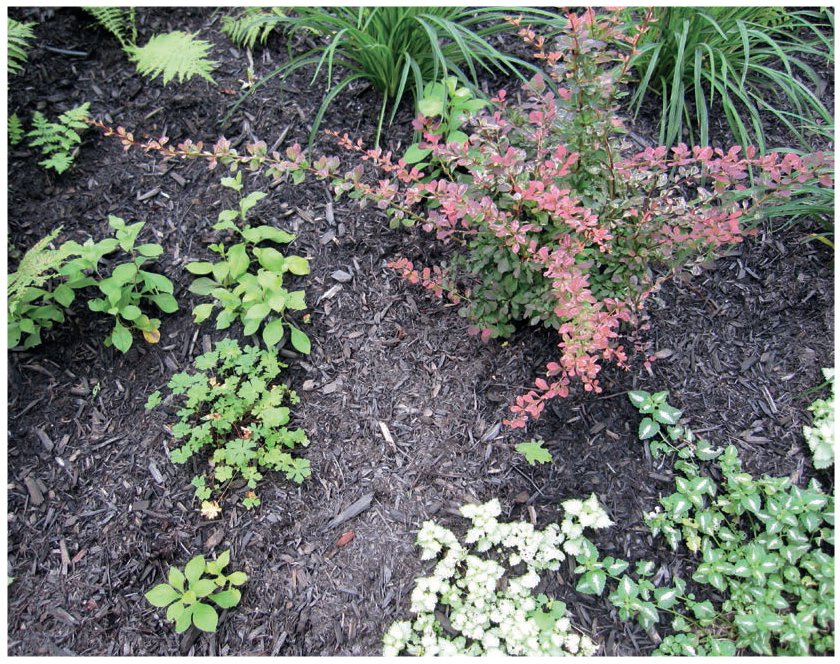
Shredded tree mulch is most effective in reducing water loss in xeriscaping.
When watering, the objective is to water deeply and less frequently (Green Venture 2010). Deep watering encourages deep root growth while shallow, frequent watering is detrimental to vegetation because it encourages shallow root growth and dependence upon the homeowner. Each type of vegetation, however, requires a different amount of water to account for a ‘deep’ watering. For shrubs and perennials, it is important to water to depth of 30 cm (1 ft) while annuals and vegetables only require a water depth of 15 to 20 cm (6 to 8 in). Trees, on the other hand, should be watered very deeply depending on the species. Aspen, birch and cedar, for example, are water-loving trees, which may require more than other tree species (Green Venture 2011).
Although the initial set-up for a xeriscape may seem expensive and daunting, the benefits reach far into the future. Personal benefits include financial savings on chemicals, fertilizers and water use, and less time spent on maintenance. These gardens also contain a unique aesthetic, character and message about the environment and our place in it.
20.1 XERISCAPED OUTDOOR SPACES |
|
Project |
Residence for a Briard |
Location |
Culver City, California, USA |
Architect |
Sander Architects |
To architect Whitney Sander, the Residence for a Briard is known as the first ‘hybrid house’, while for others, it is an integration of eco-friendly construction and affordable living that meets the requirements of its occupants. Featuring ecological interventions and cutting-edge technology, the residence, situated in Culver City, California, is a duplex that was built under a budget constraint. While the client did not have special requirements, the architect efficiently integrated systems that optimize water usage and xeriscaped gardens.
The house, with an area of 353 m2 (3,800 sq ft), was constructed from cost-saving prefabricated, recycled steel frames. The pieces were delivered by the manufacturers and completed on-site to form a two-storey house within three weeks.
One particularly notable feature of the house is its water-usage efficiency. Following thoughtful site planning and design, the architects selected plants that require minimal irrigation and maintenance. In addition, an outdoor cistern was installed to capture rainwater for various water uses, including garden irrigation. Furthermore, with a built-in grey water system, water from the sinks and showers can be reused, thereby reducing fresh water consumption from external sources.

The dwelling is an integration of eco-friendly construction and affordable living.
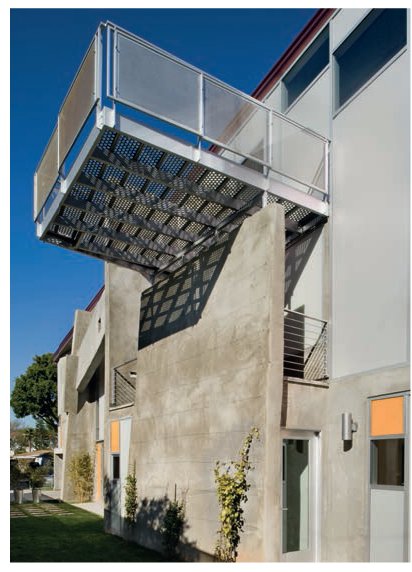
The house was constructed with prefabricated steel frame components.

Site and ground floor plans showing the xeriscaped area.
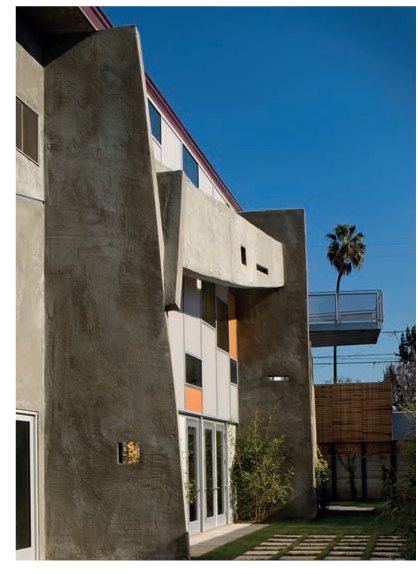
Rear facade of Residence for a Briard. The walls were insulated with recycled denim.
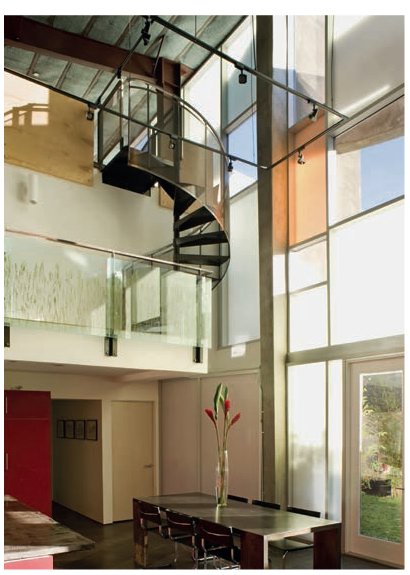
The transparent facade lets in ample amounts of natural light.
The steel frames create special interior qualities. With the living space spanning across a height of 8.5 m (28 ft), the space is characterized by a vast amount of natural light reflecting off the crisp edges of the I-beams, hanging light fixtures and stained concrete floors. The walls are clad with green materials such as sunflower seed wallboards. The dining, kitchen and living spaces, which are organized on the first floor, face south and are connected to an outdoor terrace.
The architect also integrated ecological techniques indoors. The house maintains a constant temperature and minimizes energy use through a building envelope that is well insulated with a material made from recycled denim. Equipped with low-flush toilets, sustainable kitchen and bathroom cabinetry and Energy Star appliances, sustainability is an integral part of the occupants’ lifestyle.
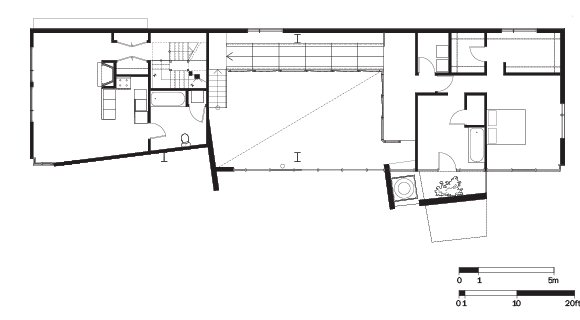
The first floor shows the two sections of the house which are connected by a bridge.
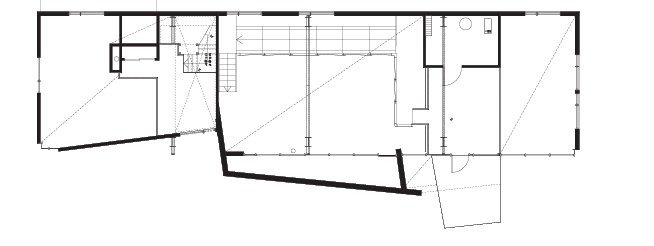
Mezzanine showing the two-storey spaces.

Longitudinal section.
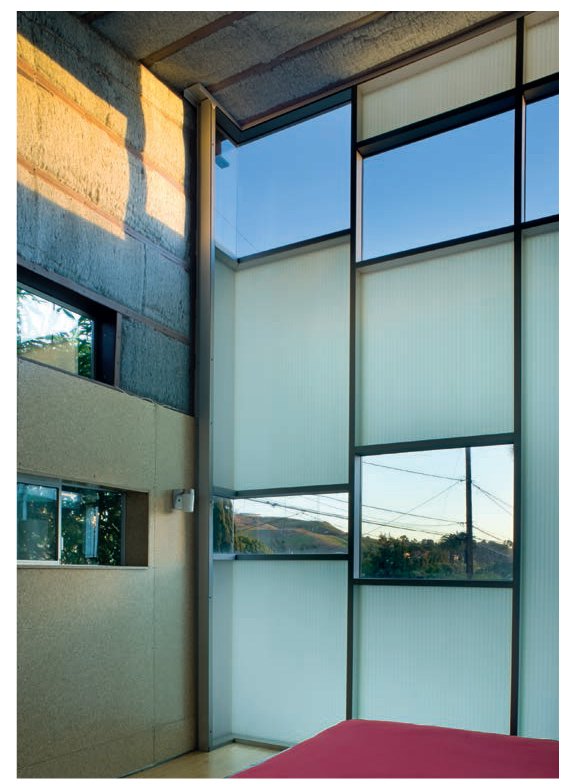
Facade detail demonstrating its transparency.
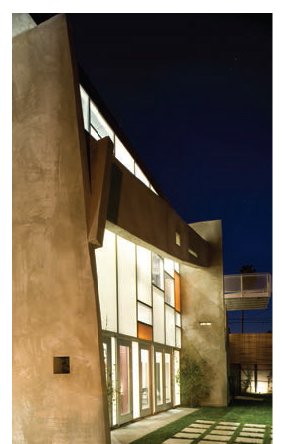
Rear elevation at nighttime.

Cross section.
20.2 XERISCAPED OUTDOOR SPACES | |
Project |
Jacobson Residence |
Location |
Los Angeles, California, USA |
Architect |
Wick Architecture and Design |
The Jacobson Residence, located in the San Fernando Valley, Los Angeles, is ‘green’ both inside and out. Designed by Wick Architecture and Design, this 372 m2 (4,000 sq ft) house earned certification by both Build It Green and Energy Star for its sustainability. Situated on a tight urban site, Wick’s design focused on using eco-friendly materials and being energy and water efficient. For instance, large windows in each room draw in abundant natural light, as well as enabling sufficient natural ventilation, which effectively keep energy costs down.
While the house was built with green components, such as a basement made from insulated concrete forms, radiant barrier roof panelling and a cool roof, the outdoors was also designed with sustainability in mind. A splayed slot garden is situated in the dwelling’s centre, which helps to bring natural light and breezes to all spaces. Moreover, the central and exterior gardens both use xeriscaping techniques.
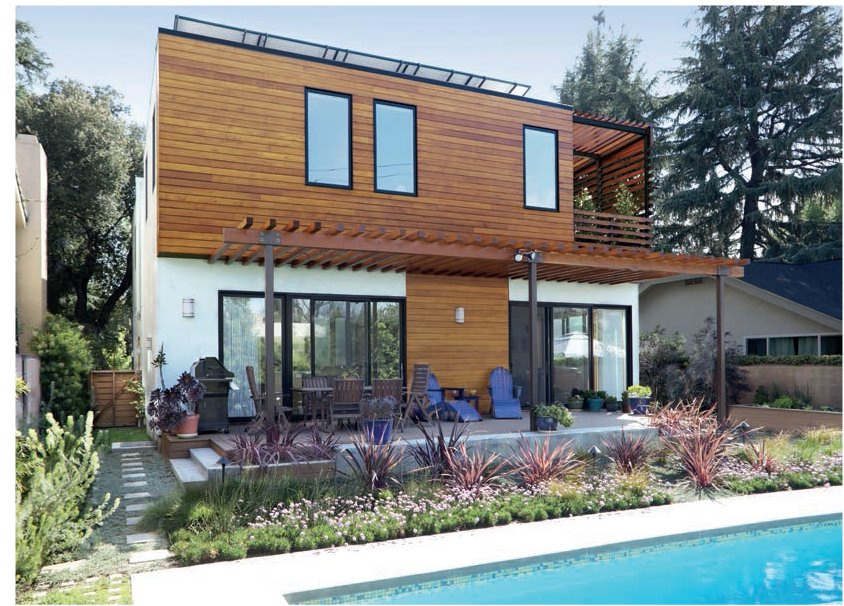
The house, situated on a tight urban site, uses many eco-friendly features.
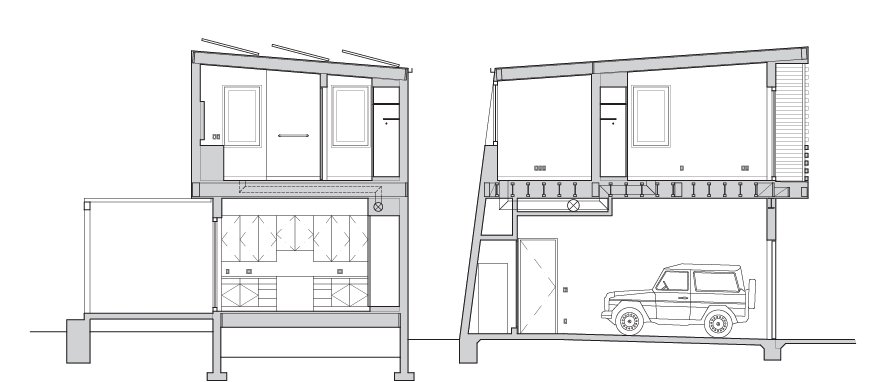
Sections through the dwelling. Water harvesting features have been installed on the roof.
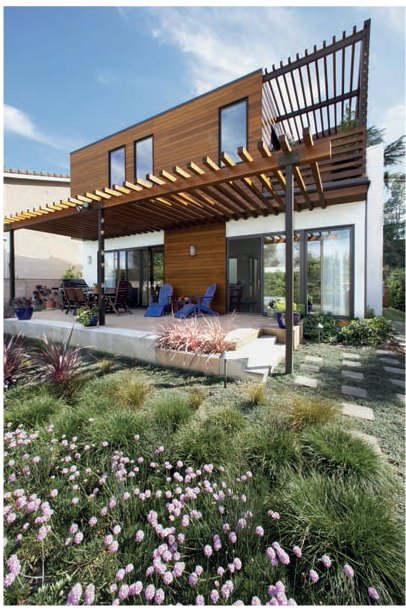
Rear view of the xeriscaped garden, which includes many native plants.
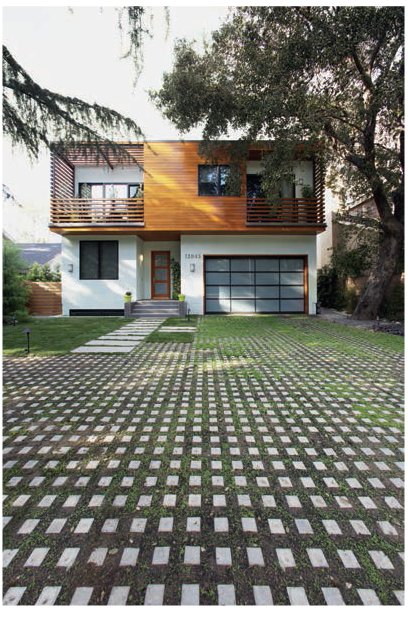
The permeable pavers help in storm-water management.
With landscape design by Fletcher Studio and rainwater recycling system by Fountainhead, Wick strategically built a roofline that is tilted in three directions, which allows rainwater to flow to a central storage tank for reuse.
As a result, the occupants of the Jacobson Residence are able to collect all the rainwater, which they can then used to irrigate their garden. The use of xeriscaping enables the maintenance of the gardens on rainwater alone, significantly reducing water consumption during the dry season.
With the objective of conserving energy and water, xeriscaping has become an integral part of green home designs. Notable approaches to xeriscaping include retaining as much of the native vegetation as possible – since most is accustomed to the local climate – and placing plants in ways that optimize sun exposure, which also helps to support energy efficiency in the house. While it may require some more careful planning than conventional landscaping methods, xeriscaping can contribute to the creation of beautiful and sustainable outdoor living spaces.

Ground floor features a central xeriscaped garden (left), which is also visible from the first floor (right).
View of the living space, and the central and rear gardens.
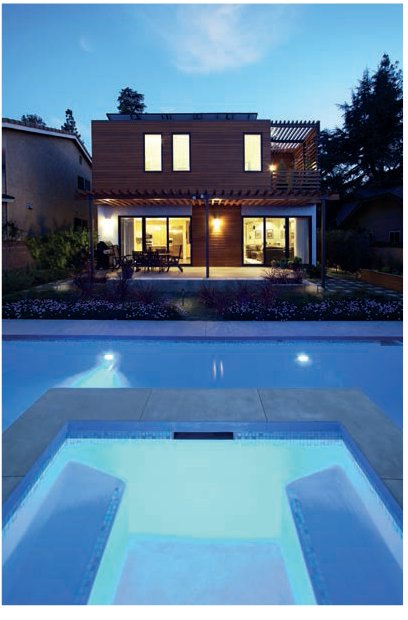
View of the rear facade at nighttime.
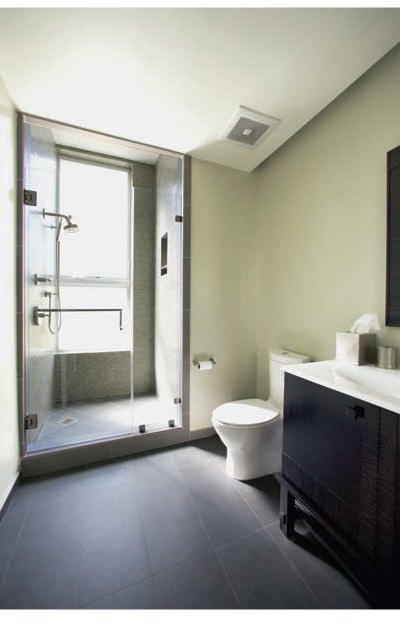
The lower floor bathroom that contains water-saving features.

